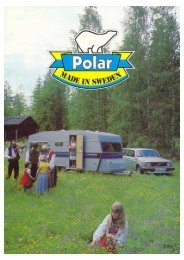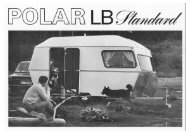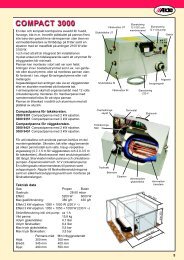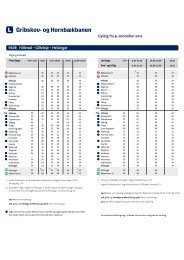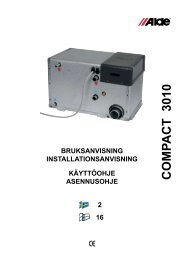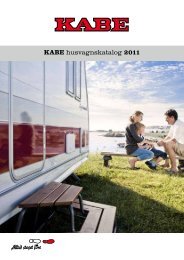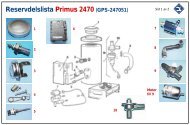bruk 2928.indd - Norrlandsvagnar
bruk 2928.indd - Norrlandsvagnar
bruk 2928.indd - Norrlandsvagnar
Create successful ePaper yourself
Turn your PDF publications into a flip-book with our unique Google optimized e-Paper software.
GB<br />
230/240-volt cable. The immersion heater and the<br />
circulation pump will then start up thanks to the battery<br />
eliminator transforming down the voltage to 12 volts.<br />
4:0 Water heater<br />
The LPG boiler can be equipped with a stainless steel<br />
water heater, with a volume of 7 litres of stored fresh<br />
water. A maximum capacity of about 12.5 litres of hot<br />
water at 40 ° C can be obtained.<br />
When the water heater is to be used, the LPG boiler<br />
should be started about 20 minutes in advance, and run<br />
at maximum boiler temperature to obtain the maximum<br />
amount of hot water. If an immersion heater is used<br />
instead of gas, the heating period is longer.<br />
Always flush out the water heater before it is used, particularly<br />
when it has not been used for a some time.<br />
NB. Although the water heater is protected against<br />
frost, fresh water in the heater must always be drained<br />
out when there is risk of frost and the vehicle<br />
is not in use.<br />
Drain the heater like this:<br />
Empty the fresh water tank. Open the drain cock on the<br />
water pipe (fig 6 b), and the air screw (fig 6 c) on the<br />
heater and empty out the water in the heater. If there is<br />
no drain cock, release the hose from the nipple on the<br />
heater instead. Allow it to stand like this until you use<br />
the vehicle again.<br />
If the vehicle is equipped with a pressure-controlled<br />
pump, it must be switched on. Drain the fresh watertank.<br />
Open the water taps and empty the fresh water system.<br />
Switch off the pump. Open the drain cock on the water<br />
pipe (fig 6 b), and the air screw (fig 6 c) on the heater<br />
and leave taps open. Allow it to stand like this until the<br />
vehicle is to be used again.<br />
5:0 Maintenance of the heating system<br />
Check regularly the level of liquid for the heating system<br />
in the boilerʼs expansion vessel. The level should be<br />
about 1 cm above the min. line when the boiler is cold.<br />
The system should be filled with a 40% glycol mixture of<br />
the same type as used in car engines (not diesel). If the<br />
heating system is exposed to temperatures lower than<br />
-25 ° C , the glycol content should be raised, but must not<br />
exceed 50%. The percentageglycol content should be<br />
checked before more liquid is added. This is to prevent<br />
an excessive concentration of glycol in the mixture.<br />
The glycol mixture should be replaced every other year,<br />
as its properties, such as corrosion protection, deteriorate.<br />
Never let the heating system stand without the glycol,<br />
water liquid.<br />
If the liquid level in the expansion vessel falls for reasons<br />
other than pure evaporation, check that all joints, the drain<br />
cock and air screws are tight. If glycol water has leaked<br />
out, rinse with water and mop up.<br />
Donʼt forget to check the gas system regularly to ensure<br />
that connections and hoses are not leaking.<br />
LPG hoses should be replaced every other year as they<br />
dry out and crack, which may give rise to leakage.<br />
Topping up with liquid:<br />
Make sure that the vehicle is parked horizontally before<br />
topping up, so that no air pockets can be formed. Check<br />
that air screws and the drain cock are closed. Remove<br />
the upper front cover (see fig 7) pull it upwards, the bottom<br />
outwards and then downwards. Release the nut on<br />
the expansion vessel and lift up the pump. Pour in the<br />
glycol mixture slowly.<br />
NB. Alcohol must not be used as anti-freeze. Radiator<br />
cement must not be mixed in the system.<br />
5:1 Bleeding the heating system<br />
When filling the system, air pockets may form, depending<br />
on how the system was installed. A sign that there is air in<br />
the system is when the heat will only travel a few metres<br />
along the radiator system from the boiler, even though<br />
the circulation pump is running.<br />
Bleed the system like this:<br />
The boiler should be running and the circulation pump off.<br />
Start by opening the air screws (the vehicleʼs instruction<br />
book will show you where they are located). Leave them<br />
open until water comes out of nozzle. Start the circulation<br />
pump and allow it to run for a while. Feel the pipes and<br />
radiators in the vehicle to see it they are getting warm.<br />
If it is hard to get the air out of the system, you<br />
can do as follows:<br />
Stop the circulation pump. Jack up the vehicle at the back<br />
or park it on a downhill slope (see fig 8). Allow it to stand<br />
a few minutes so that the air gets to the top of the system.<br />
Open the air screw at the highest point and leave it open<br />
until the air has come out. Then raise the vehicle at the<br />
front and repeat the procedure in this position (see fig<br />
9). Place the vehicle on the level and start the circulation<br />
pump. When flow and return pipes are almost the same<br />
temperature, the system is free of air. When bleeding<br />
caravan systems, the easiest way of raising and lowering<br />
the vehicle is by using the support wheel. When the<br />
system has just been filled, small air bubbles may form<br />
in the expansion vessel. Stop the circulation pump for a<br />
few seconds and they usually disappear.<br />
Figs 8-9 A. Air screw B. Air<br />
6:0 Useful facts about LPG<br />
LPG is a petroleum product and the letters stand for<br />
Liquefied Petroleum Gas. It is available as propane and<br />
butane. Propane has the advantage that it is gaseous<br />
down to -40 ° C, while butane works unsatisfactorily below<br />
10 ° C. That is why propane is the most suitable type.<br />
When the cylinder valve is opened, the LPG liquid turns<br />
in released as a gas. When LPG burns, carbon dioxide<br />
(CO 2<br />
) and water vapour only are emitted, just like in the air<br />
we breathe out. In order for combustion to be complete,<br />
a good air supply is required. LPG is very environment<br />
friendly and does not generate soot on complete combustion.<br />
It can be stored in cylinders for any length of time<br />
without its quality deteriorating. LPG is entirely free of<br />
poisonous substances.<br />
15










